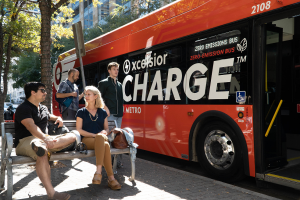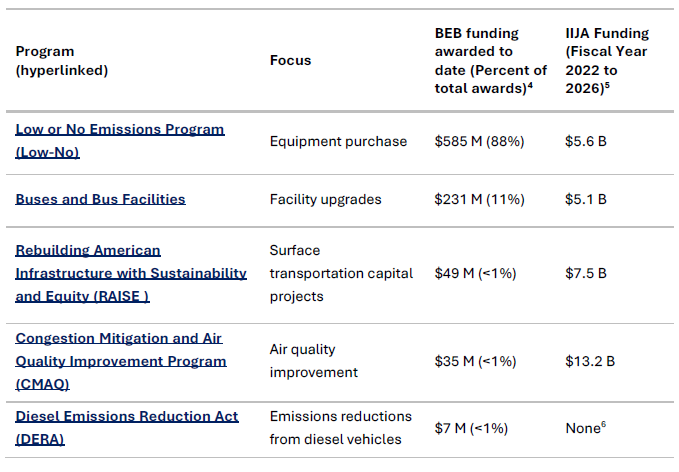4 main takeaways from America’s top transit agencies on electrifying buses
 Many U.S. transit agencies, from New York to Los Angeles to Houston, are working to convert their bus fleets from diesel to electric. The number of electric transit buses currently on order or operating in the U.S. grew 112% from 2018 to 2021, according to CALSTART. Electric buses are cleaner, quieter and increasingly more cost-effective than traditional diesel-powered alternatives.
Many U.S. transit agencies, from New York to Los Angeles to Houston, are working to convert their bus fleets from diesel to electric. The number of electric transit buses currently on order or operating in the U.S. grew 112% from 2018 to 2021, according to CALSTART. Electric buses are cleaner, quieter and increasingly more cost-effective than traditional diesel-powered alternatives.
While many makes and models of electric buses are now available to address transit agencies’ needs, charging is still a significant hurdle. Transit agencies are faced with the complexity of determining charging infrastructure needs while maintaining operations and reducing costs, which can be a maze of decisions and obstacles to overcome.
To uncover the emerging trends, barriers and best practices these agencies are implementing to meet their own electrification goals, EDF worked with Atlas Public Policy to interview 28 transit agencies in the process of electrifying their fleets, as well as utilities, engineering firms, charging manufacturers and thought leaders in transit charging. The results are highlighted in a new report out today entitled, Deploying Charging Infrastructure for Electric Transit Buses: Best practices and lessons learned from deployments to date.
Here are four main takeaways:
1. Leverage available funding support
The significant upfront costs of battery electric buses and charging infrastructure paired with fuel savings over the lifetime of the vehicle represent a new financial model for agencies that have been operating non-electric fleets. Agencies’ existing financial planning may not account for the increased capital expenditures and decreased operating costs that come with an electric fleet. Therefore, leveraging funding from federal, state, municipal and utility programs will be vital for some agencies when exploring early-stage electrification.
Luckily, many funding support programs are emerging. The Infrastructure Investment and Jobs Act, passed by Congress in November 2021, authorizes up to $108 billion for federal public transportation programs, including more than $30 billion for programs that have historically funded electric buses. Further, the federal Low- or No-Emissions Program is dedicated entirely to funding alternative fuel transit buses.
Table 1: Potential Federal Funding Sources for Electric Buses and Charging
Many states are also providing funding to support transit charging, such as Volkswagen settlement funds, voucher programs, fuel standards, as well as utility programs such as site and grid upgrade support as well as fleet advisory services.
2. Work with your utility as early as possible
A transit agency’s local utility will be the single most important partner when developing a charging infrastructure plan. The utility can help determine which sites are most viable to buildout in the short term without delays and what electricity rates are best suited for a particular site. They can also advise on solutions to ensure reliability and reduce charging costs, such as managed charging and on-site solar and storage. Further, as charging needs for transit buses often require significant power, upgrades to the electricity grid will be inevitable. These upgrades can cause significant delays and be costly to both the utility as well as the transit agency. Therefore, it is important for transit agencies to work with their local utility to develop long-term electrification plans, which will ensure grid capacity to support charging.
3. Design. Pilot. Repeat.
It is recommended by many transit agencies to have multiple design phases. First, transit agencies need to do an energy needs assessment to select which routes are prime for electrification now, but also to evaluate how operations could be modified to make electrification more viable. Second, as many agencies are learning along the way, a trend across the board is conducting small pilots first before scaling. This achieves the goals of teaching staff about these new technologies, while also assessing if a certain solution will meet their needs. Agencies need to answer questions such as depot versus enroute charging, what staffing changes might be needed, as well as what charging station ratios, models and power levels are required — all of which can vary by transit agency and depot site. Therefore, it is key to leverage learnings from agencies who have already started this journey and partner with industry experts to ensure charging is designed to minimize costs are and operational disturbances.
4. Start with contracts to ensure charging reliability
Charging equipment reliability is paramount for agencies to operate. As more charging equipment models and capabilities emerge, this can lead to/cause confusion and gaps into which best suit an agency’s needs.
One way transit agencies are addressing this head-on is by initiating contract requirements with charging station manufacturers and vendors to ensure that equipment delivered meets what was promised. These contract requirements can vary from hardware and software compliance standards, long-term maintenance of equipment, remote monitoring and diagnostics to ensure depot sites are running optimally. Setting clear expectations in contracts with charging providers safeguards transit agencies from stranded assets, but also futureproofs equipment to maximize their lifetime viability.
How can we further support transit agencies’ transition to electric?
In all interviews conducted, agencies were asked how best they can be supported moving forward. Almost unanimously upfront funding for buses and charging infrastructure, in the short term, remains a significant barrier for agencies. Continued funding support to drive down costs and support fuel costs savings will be vital to ensuring adequate and reliable charging is available for agencies to meet their operational needs. Further support on workforce training and expertise to maximize operations to support electrification would be key to meeting 100% electrification goals.
Finally, reliability of charging was a great concern. Having clear performance standards for both the hardware and installed software used with charging systems will be key to ensuring reliable and future-proofed equipment for agencies to invest in.
Transit agencies are driving forward with electrification across the U.S. Government and industry partners must work together to find technical, policy and financial solutions to ensure this transition is just, cost effective and beneficial for all energy transition goals.











